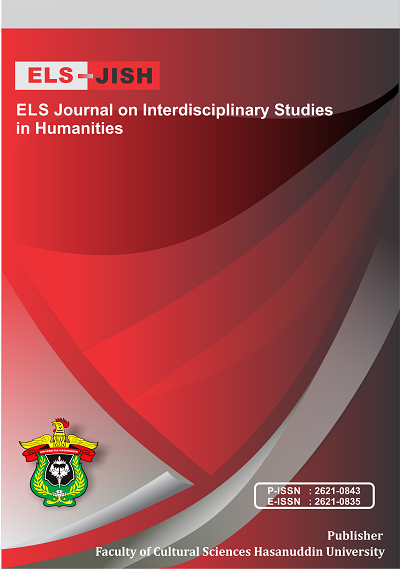Bhatanda Ilila Song Meanings of The Ciacia La Poro Community to The Study of Literature and Culture
DOI:
https://doi.org/10.34050/elsjish.v5i2.21219Keywords:
Bhatanda Ilila Song, Meanings, Poems, Ciacia, Laporo EthnicAbstract
The problem of this research is how the meaning of the song Bhatanda Ilila in the Ciacia community, Karya Baru Village, Sorawolio District. The purpose of this study was to describe data about the meaning of the poem Song Bhatanda Ilila in the Ciacia Laporo community in Karya Baru Village, Sorawolio District. To achieve the objectives of this study, Leech's (1991) theory of meaning is used as the main theory, as well as supporting theories, such as the theory of literature, oral literature, and folk songs. This research is classified as a type of field research with a qualitative descriptive method. The data in this study are oral speech containing the meaning of Bhatanda Ilila's song recorded from informants or native speakers who use the Cia-cia Laporo language. Data collection techniques used are recording techniques and note-taking techniques. Data were analyzed descriptively through stages; transcription of data records, data classification, data translation, data analysis, conclusions. The results of the research on the meaning of Nyanyian Bhatanda Ilila of the Ciacia Laporo ethnic community in Karya Baru Village, Sorawolio District, are: (1) Data 01 or the first verse contains the affective meaning of two data, and the reflective and connotative meaning of each data. While data 02 or the second verse contains the connotative meaning of two data, and the affective meaning and conceptual meaning of each one data. (2) Data 03 or the third verse contains affective meaning and reflective meaning each one data, and connotative meaning there are two data. Furthermore, data 04 or the fourth verse contains affective meaning and connotative meaning each one data, and reflective meaning contains two data. (3) Data 05 or the fifth verse contains four data connotative meanings. (4) No thematic and stylistic meanings were found in the poems of Song Bhatanda Ilila in the Ciacia Laporo ethnic community in Karya Baru Village, Sorawolio District.
References
Evang Asmawati. (2018). Bentuk, Makna Dan Fungsi Kesenian Moanggo (Nyanyian Rakyat Masyarakat Tolaki. Jurnal Akrab Juara, Volume 3(Nomor 3).
Gazali. (2016). Struktur, Fungsi, Dan Nilai Nyanyian Rakyat Kaili. Jurnal Litera, Volume 15(Nomor 1).
Geoffrey Leech. (1991). Semantics. The Chauncer Press.
Indra Putra Pahlewi. (2015). Menggali Nilai Pendidikan dalam Nyanyian Puntasua Tingkat I-III pada Masyarakat Kaongkeongkea Kabupaten Buton. Jurnal Shautut Tarbiyah, Volume 1(Nomor 32).
Munandar & Sidu Marafad& Sahlan. (2020). Nyanyian Rakyat Dalam Konteks Pendidikan Karakter Bagi Masyarakat Muna (Kajian Semiotik). Jurnal Pendidikan Bahasa Dan Sastra Indonesia, Volume 9(Nomor 1).
Nadir La Djamudi. (2005). Relevansi Nilai Sastra Lisan Wolio dengan Kondisi Sosial Budaya Masyarakat Kota Bau-Bau (Suatu Kajian Strukturalisme Genetik). Universitas Negeri Makassar.
Nasir. (2016). Nilai-Nilai Pendidikan Dalam Nyanyian Rakyat Kau Kaudara Pada Masyarakat Muna. Jurnal Humanika, Volume 1(Nomor 16).
Rahman, F. (2017). Cyber literature: A reader–writer interactivity. International Journal of Social Sciences & Educational Studies, 3(4), 156.
Rahman, F., & Letlora, P. S. (2018). Cultural Preservation: Rediscovering the Endangered Oral Tradition of Maluku (A Case Study on" Kapata" of Central Maluku). Advances in language and literary studies, 9(2), 91-97.
Sugiyartati, A., Arafah, B., Rahman, F., & Makka, M. (2020). Cultural values in oral literature of Krinok: Antropolinguistic study. Language Literacy: Journal of Linguistics, Literature, and Language Teaching, 4(2), 316-321.
Downloads
Published
How to Cite
Issue
Section
License
Copyright (c) 2022 Nadir La Djamudi

This work is licensed under a Creative Commons Attribution-NonCommercial-ShareAlike 4.0 International License.






